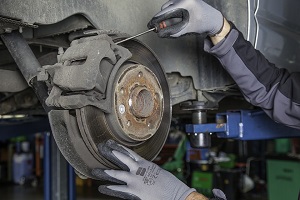Understanding Your Vehicle's Braking System

Imagine you're cruising down the highway on a bright summer day, the breeze flowing through your open windows and your favorite tunes playing loud. Suddenly, the vehicle ahead slams on its brakes, forcing you to do the same. In that split second, your brakes spring into action, preventing what could have been a dangerous collision. While this scenario might seem ordinary, it’s worth pausing to reflect on just how remarkable your braking system truly is.
Â
At first glance, your car’s brakes may not seem like much more than a simple mechanism. But when you think about it, they’re nothing short of extraordinary. After all, they’re tasked with stopping a heavy, fast-moving vehicle in its tracks with just the slightest pressure from your foot. It’s all thanks to the laws of physics that your brakes can perform such a vital task.
Â
Every time your car moves, it builds kinetic energy—essentially the energy of motion. When you press the brake pedal, your car’s braking system works to convert this kinetic energy into heat through friction. Here’s how it happens: the pedal is connected to a lever that pushes hydraulic fluid out of a master cylinder into the brake lines. These lines carry the fluid to calipers near each wheel. Once the fluid reaches the calipers, it forces the brake pads to clamp down on the rotors (or drums, depending on your vehicle). As the pads grip the rotors, friction slows the wheels, ultimately halting your car. It’s a process that happens almost instantaneously, yet it’s incredibly complex.
Â
There are two main types of brakes: disc brakes and drum brakes. Disc brakes are the more common type today, and they work by using calipers to squeeze brake pads onto a flat metal disc called a rotor. The pressure from the calipers creates friction, which slows the rotation of the rotor and, consequently, the wheel. Drum brakes, on the other hand, feature a cylindrical housing with shoes inside. When you press the brake pedal, these shoes expand outward, rubbing against the inner surface of the drum to slow the wheel. Think of it as the way you’d stop a spinning plate by pressing your hands against it.
Â
Next time you’re behind the wheel, take a moment to appreciate the intricate engineering that keeps you safe. Regular maintenance is key to ensuring your brakes continue functioning properly. Make sure to have them inspected and serviced by a professional mechanic to avoid any surprises on the road. Your brakes deserve the same attention as any other critical component of your vehicle.
Â
If you suspect your brakes need attention, don’t hesitate to schedule service. Trusting your safety to a reliable braking system is non-negotiable. So why wait? Reach out to your local mechanic today and book an appointment to keep your brakes in top condition. Your peace of mind—and potentially your life—are worth it.
Fabric cutting machine, Textile cutting machine, Automated cloth cutting machine
Zhejiang Lejiang Machine Co., Ltd. , https://www.cnlejiang.com
